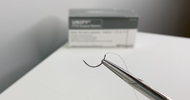Choosing the Right Surgical Suture Needle: Size, Shape, and Tip Configuration
In the realm of surgery, precision and effectiveness are of utmost importance. For each unique procedure, the selection of a surgical suture needle depends on its size, shape, and tip configuration. Read more about the significance of these features to help you choose the best suture for your application.
Needle Size
Surgical suture needles come in various sizes, primarily determined by their diameter. Smaller gauge numbers indicate larger needle diameters. The choice of needle size depends on the type and thickness of the tissue being sutured.
Smaller Needles: These are designed for delicate tissues such as blood vessels and internal organs, minimizing tissue trauma.
Medium-Sized Needles: Versatile and suitable for most general surgical procedures involving skin, muscle, or fascia.
Larger Needles: Robust needles intended for tougher tissues like tendons or bones.
Needle Shape
The shape of the needle profoundly affects its ability to penetrate and maneuver within tissues. Common needle shapes include:
Tapered Needles: These needles have a gradually diminishing diameter from the body to the tip, which reduces tissue trauma during penetration. They are suitable for delicate procedures like vascular and ophthalmic surgery.
Conventional Cutting Needles: These needles have a sharp, beveled cutting edge on the inside curve. They excel at penetrating tough tissues like skin and muscles, making them ideal for general surgeries and procedures where initial tissue penetration is crucial.
Reverse Cutting Needles: Featuring a triangular cutting edge on the backside, these needles reduce the risk of suture material cutting through tissues. They are commonly used in areas with tough or fibrous tissues, such as in oral & maxillofacial surgery, plastic surgery or orthopedics.
Spatula Needles: These needles feature a flat, paddle-like tip that facilitates precise tissue manipulation. They are often used in microsurgery, plastic surgery, and other procedures that require meticulous control.
Needle Tip Configuration
The tip configuration of a surgical suture needle is pivotal in its precision and performance. Common tip configurations include:
Round Tip: Rounded needles are employed for general soft tissue suturing, causing minimal tissue trauma.
Tapered Tip: Tapered needles sport a pointed tip for easier penetration of delicate tissues.
Blunt Tip: Blunt needles are utilized when minimizing tissue trauma is essential, as seen in neurosurgery or ophthalmic procedures.
Choosing the ideal surgical suture needle is a critical aspect of surgical practice. The selection of size, shape, and tip configuration must align with the unique requirements of each surgical procedure and the properties of the tissues being sutured. A comprehensive understanding of these factors empowers surgeons to optimize patient outcomes by minimizing tissue damage, ensuring secure wound closure, and promoting efficient healing. Ultimately, the choice of needle represents a vital element in the surgeon's toolkit, contributing to the art and science of surgery.

